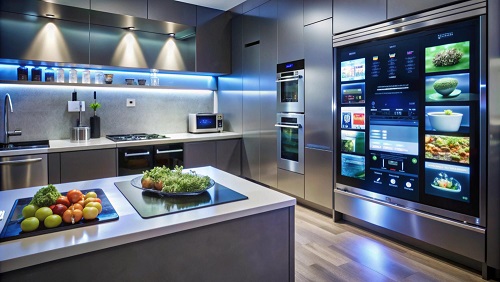The kitchen has always been the heart of the home, but today it is undergoing a remarkable transformation. With modern technology, sustainable choices, and an emphasis on lifestyle, the kitchens of the future are no longer just about cooking — they are about connection, efficiency, and beauty. Homeowners across Australia are now prioritising smart, sleek, and functional designs that elevate both daily living and long-term value.
Whether you’re considering a renovation or planning your dream home, understanding the trends shaping modern kitchens can help you create a space that feels timeless while catering to your needs.
Why the Modern Kitchen Matters
Gone are the days when kitchens were tucked away as purely functional rooms. Today’s kitchens are:
- Multi-functional – doubling as dining areas, home offices, or entertainment hubs.
- Technologically advanced – with appliances that think for you.
- Stylishly minimal – clean lines, integrated storage, and sleek finishes.
- Sustainably conscious – reducing energy use and waste without compromising on luxury.
This evolution is driven by a desire for convenience, wellbeing, and sustainability. A well-designed kitchen not only enhances lifestyle but also significantly boosts property value.
Key Features of the Future Kitchen
1. Smart Technology Integration
Smart kitchens are no longer futuristic concepts; they are becoming mainstream. From appliances to lighting, homeowners are embracing tech to simplify their routines.
Examples of smart features include:
- Fridges with internal cameras to track groceries.
- Ovens that can be preheated remotely via apps.
- Voice-activated taps and lights for hands-free convenience.
- Energy-efficient dishwashers that optimise water use.
Smart technology doesn’t just make cooking easier—it also helps save time and energy, aligning with modern sustainable living.
2. Sleek Minimalist Designs
Minimalism has become a hallmark of modern kitchens. Designers are moving towards clutter-free layouts that blend functionality with elegance.
Popular minimalist elements include:
- Handleless cabinetry with push-to-open systems.
- Concealed appliances integrated seamlessly into joinery.
- Neutral tones paired with natural textures like timber and stone.
- Slimline benchtops for a streamlined finish.
This clean look not only creates a calming environment but also makes the kitchen appear more spacious and welcoming.
3. Functionality at the Forefront
No matter how stylish a kitchen looks, functionality remains the cornerstone of good design. Designers now emphasise layouts that optimise flow and usability.
Functional design trends include:
- The working triangle – perfect alignment between sink, stove, and fridge.
- Zoned storage – creating designated areas for prep, cooking, and cleaning.
- Flexible spaces – island benches that double as study desks or serving stations.
- Ergonomics – cabinetry heights and drawers tailored for ease of use.
In practical terms, this ensures your kitchen is enjoyable not just for cooking, but also for socialising, working, or relaxing.
Sustainable Choices for Tomorrow’s Kitchens
Sustainability is no longer an afterthought. Australians are increasingly choosing eco-friendly kitchen solutions that are both stylish and responsible.
Eco-conscious upgrades include:
- Energy-efficient induction cooktops.
- Water-saving taps and dishwashers.
- LED lighting systems.
- Recycled or sustainably sourced materials for cabinetry and benchtops.
Incorporating green choices not only lowers your environmental footprint but also saves money in the long term.
Real-Life Scenario: A Perth Kitchen Transformation
Take the example of a family who recently undertook kitchen remodelling in Perth. Their old kitchen was outdated and cluttered, with little storage and inefficient appliances. By working with a design team, they transformed it into a modern, functional space featuring an open-plan layout, smart appliances, and sustainable finishes.
The result? A kitchen that’s now the family’s favourite room—perfect for cooking, entertaining, and even homework time.
How to Future-Proof Your Kitchen
If you’re planning a kitchen renovation, here’s a simple checklist to guide your decisions:
Future-Proof Kitchen Checklist:
- Opt for smart appliances with energy-saving features.
- Choose timeless finishes over fleeting design trends.
- Invest in quality cabinetry and benchtops for durability.
- Incorporate ample storage with pull-out pantries and deep drawers.
- Design for flexibility—multi-purpose islands are a must.
- Add sustainable solutions wherever possible.
By following this approach, you’ll ensure your kitchen remains functional and stylish for years to come.
Frequently Asked Questions
1. What makes a kitchen “smart”?
A smart kitchen uses technology like Wi-Fi-enabled appliances, voice control, and automation to make cooking and cleaning more efficient.
2. Is a minimalist design practical for families?
Yes. With thoughtful storage solutions and durable finishes, minimalist kitchens are highly functional and easy to maintain.
3. How much does it cost to remodel a modern kitchen?
Costs vary depending on size, materials, and finishes. Smart appliances and premium materials may increase the budget but add long-term value.
4. What’s the most important factor in future-proofing a kitchen?
Prioritising functionality and flexibility. A well-planned layout with quality materials ensures your kitchen adapts to changing needs.
5. Can I make my kitchen sustainable without a full renovation?
Absolutely. Simple upgrades like LED lighting, water-efficient taps, and energy-smart appliances can make a big difference.
Conclusion
The kitchens of the future are smart, sleek, and functional—spaces that combine technology, beauty, and sustainability. Whether you’re inspired by minimalist elegance or cutting-edge appliances, a well-designed kitchen will always enhance your lifestyle.
If you’re ready to start planning your dream space, now is the perfect time to explore modern design solutions that suit your needs. A functional and stylish kitchen isn’t just an upgrade—it’s an investment in your home and wellbeing.








Leave a Reply